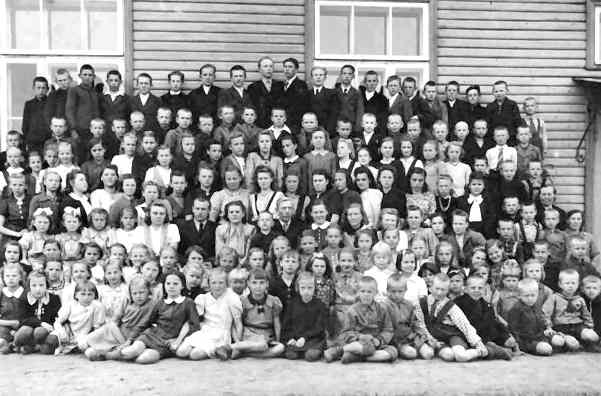
Estonian Schools

Figure 1.--This photograph shows an Estonian primary schhol in 1947 just after World War II. The school is still operating. We note boys wearing short pants including suspender shorts. One boy wears a sailor suit. There seem some rather old boys at the back, perhaps their education was delayed by World War II. Many boys have short, cropped hair.
|
|
Estonia has been dominated by Sweden and Russia and strongly influenced by Germany and the country's education system strongly reflects these influemces. The oldest educational facility in Estonia is the University of Tartu, establisged in 1632. The University was founded by Gustaf Adolf, King of Sweden, when the Swedes controlled Estonia. The language of instruction and most of the doctoral theses were in German until 1919. The educational system was heavily influenced by the Soviet system after the country was invaded and annexed by the Soviet Union (1940). We note boys without school uniforms right after World War II (figure 1). We note boys wearing short pants including suspender shorts. One boy wears a sailor suit. There seem some rather old boys at the back, perhaps their education was delayed by World War II. Many boys have short, cropped hair. Presumably as the country began to recover from the War, the standard Soviet school uniform became more common. Since independence, Estonian school children no longer wear uniforms. I'm unsure just what other changes have taken place in education since independence. One change is there are now schools that operate in the Estonian as well as the Russian language.
Estonia has been dominated by Sweden and Russia and strongly influenced by Germany. There are also linguistic and cultural afinities wsith Finland o the north. The country's education system strongly reflects these influemces. The oldest educational facility in Estonia is the University of Tartu, established in 1632. The University was founded by Gustaf Adolf, King of Sweden, when the Swedes controlled Estonia. Estonian was seized by Tsarist Russia in the Great Northern War (18th century). Even so, The language of instruction at the university level and most of the doctoral theses were in German until Tsar Alexander III's Rissification process. We know less about the primary and secondary schools. Estonia became independent after World War I. Schools were opened usung Estonian. We are unsure about schools for minority groups, Germans and Russians. Also all of the ethnic Germans returned to the Reich at the onset of World War II. The educational system was heavily influenced by the Soviet system after the country was invaded and annexed by the Soviet Union (1940). The language of instruction became Russian. I'm unsure just what other changes have taken place in education since independence. The lanuage of instruction became Estonian. A reader tells us that there are schools that operate in the Estonian as well as the Russian language. This probably reflects the substantial Russian population in Estonia.
School uniforms were worn during the Tsarist era. Boys in secondary schools wore cadet uniforms. We have little information about Estonian schools after independence during the inter-war era, but we notice many girls wearing pinafores. We note boys without school uniforms right after World War II (figure 1). We note boys wearing short pants including suspender shorts. One boy wears a sailor suit. There seem some rather old boys at the back, perhaps their education was delayed by World War II. Many boys have short, cropped hair. Presumably as the country began to recover from the War, the standard Soviet school uniform became more common and by the 1950s required. Children throughout the Soviet Union wore the same uniform. Boys wore a military-style uniform. Since independence, Estonian school children no longer wear uniforms.
Individual Schools
Finding information on individual schools in small countries like Estonia is difficult. We have found a Tartu school in 1913. Estonia at the timw was still part of the Russian Empire. The image we found looks to be the entry-level class at a secondary school. Unlike most Russoan Empire schppl, it was a coed class.
HBC

Related Chronolgy Pages in the Boys' Historical Web Site
[The 1880s]
[The 1890s]
[The 1900s]
[The 1910s]
[The 1920s]
[The 1930s]
[The 1940s]
[The 1930s]
[The 1940s]
[The 1950s]
[The 1960s]
[The 1970s]
[The 1980s]
Related Style Pages in the Boys' Historical Web Site
[Smocks]
[Long pants suits]
[Knicker suits]
[Short pants suits]
[Socks]
[Eton suits]
[Jacket and trousers]
[Blazer]
[School sandals]
[School smocks]
[Sailor suits]
[Pinafores]
[Long stockings]
Navigate the HBC Shool Setion
[Return to the Main European national school page]
[Return to the Main Estonian page]
[About Us]
[Activities]
[Chronology]
[Clothing styles]
[Countries]
[Debate]
[Economics]
[Garment]
[Gender]
[Hair]
[History]
[Home trends]
[Literary characters]
[School types]
[Significance]
[Transport and travel
[Uniform regulations]
[Year level]
[Other topics]
[Images]
[Links]
[Registration]
[Tools]
[Return to the Historic Boys' School Home]
Created: April 8, 2004
Last updated: 6:37 PM 5/12/2016




